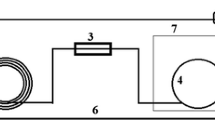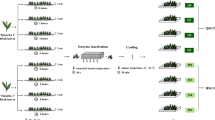Abstract
The aim of this study was to determine the physico-chemical parameters [glucose, fructose and sucrose content, pH, moisture content, aw, refraction index, Brix concentration, free acidity, ash content, electrical conductivity, colour parameters (L*, a*, b*, chroma, hue angle, yellow index)] of five different honey types from Romania. The honey types were: acacia, sunflower, tilia, honeydew and polyfloral. For this study 50 samples of honey were used. The pH ranged between 3.88 and 6.39, aw ranged between 0.476 and 0.603, free acidity 3.40–37.10, moisture content 14.44–19.80%, electrical conductivity ranged between 109.9 and 1276.8 µS/cm, ash content 0.05–0.63%, L* 19.60–48.08, a* −1.96 to 7.68, b* 4.16–18.24, chroma 6.53–18.32, hue angle −13.44 to 17.01, yellow index 21.89–70.20, fructose content 33.64–47.31%, glucose 22.06–38.25%, sucrose 0–2.71%, and fructose and glucose contents sum 66.62–79.94%. The authentication of honeys was made using the Linear Discriminant Analysis (LDA) and Principal component analysis (PCA). According to the LDA, 94.00% of the honey was correctly classified using these physico-chemical parameters.



Similar content being viewed by others
References
Codex Alimentarius, Revised codex standard for honey (2001)
A. Lazaridou, C.G. Biliaderis, N. Bacandritsos, A.G. Sabatini, Composition, thermal and rheological behavior of selected Greek honeys. J. Food Eng. 64, 9–21 (2004)
G.A. Nayik, V. Nanda, Physico-chemical, enzymatic, mineral and colour characterization of three different varieties of honeys from Kashmir valley of India with a multivariate approach. Polish J. Food Nutr. Sci. 65, 101–108 (2015)
E. De la Fuente, M.L. Sanz, I. Martínez-Castro, J. Sanz, Development of a robust method for the quantitative determination of disaccharides in honey by gas chromatography. J. Chrom. A 1135, 212–218 (2006)
M.V. Baroni, M.L. Nores, M.D.P. Díaz, G.A. Chiabrando, J.P. Fassano, C. Costa, D.A. Wunderlin, Determination of volatile organic compound patterns characteristic of five unifloral honey by solid-phase microextraction-gas chromatography-mass spectrometry coupled to chemometrics. J. Agri. Food Chem. 54, 7235–7241 (2006)
M. Kassim, M. Achoui, M.R. Mustafa, M.A. Mohd, K.M. Yusoff, Ellagic acid, phenolic acids, and flavonoids in Malaysian honey extracts demonstrate in vitro anti-inflammatory activity. Nutr. Res. 30, 650–659 (2010)
N. Gheldof, X.H. Wang, N.J. Engeseth, Identification and quantification of antioxidant components of honeys from various floral sources. J. Agri. Food Chem. 50, 5870–5877 (2002)
M.E. Conti, J. Stripeikis, L. Campanella, D. Cucina, M.B. Tudino, Characterization of Italian honeys (Marche Region) on the basis of their mineral content and some typical quality parameters. Chem. Cen. J. 1, 1 (2007)
P. Pohl, Determination of metal content in honey by atomic absorption and emission spectrometries. TrAC Trend. Anal. Chem. 28, 117–128 (2009)
J.M. Alvarez-Suarez, S. Tulipani, S. Romandini, E. Bertoli, M. Battino, Contribution of honey in nutrition and human health: a review. Medit. J. Nutr. Met. 3, 15–23 (2010)
S. Bogdanov, T. Jurendic, R. Sieber, P. Gallmann, Honey for nutrition and health: a review. J. Am. Col. Nutr. 27(6), 677–689 (2008)
M.E. Conti, M.G. Finoia, L. Fontana, G. Mele, F. Botrè, I. Iavicoli, Characterization of Argentine honeys on the basis of their mineral content and some typical quality parameters. Chem. Cen. J. 8, 1 (2014)
L.E. Revell, B. Morris, M. Manley-Harris, Analysis of volatile compounds in New Zealand unifloral honeys by SPME–GC–MS and chemometric-based classification of floral source. J. Food Meas. Char. 8, 81–91 (2014)
Council Directive 2001/110/EC relating to honey. Off. J. Eur. Comm. L10, 47–52 (2001)
I.K. Karabagias, M.V. Vavoura, C. Nikolaou, A.V. Badeka, S. Kontakos, M.G. Kontominas, Floral authentication of Greek unifloral honeys based on the combination of phenolic compounds, physicochemical parameters and chemometrics. Food Res. Int. 62, 753–760 (2014)
J.M.B. de Sousa, E.L. de Souza, G. Marques, M. de Toledo Benassi, B. Gullón, M.M. Pintado, M. Magnani, Sugar profile, physicochemical and sensory aspects of monofloral honeys produced by different stingless bee species in Brazilian semi-arid region. LWT-Food Sci. Tech. 65, 645–651 (2016)
J. Louveaux, A. Maurizio, G. Vorwohl, Commission internationale de botanique apicole de l’UISB Les méthodes de la mélisso-palynologie. Apidologie 1(2), 211–227 (1970)
I. Dobre, L.A. Georgescu, P. Alexe, O. Escuredo, M.C. Seijo, Rheological behavior of different honey types from Romania. Food Res. Int. 49(1), 126–132 (2012)
S. Bogdanov, Harmonised methods of the international honey comission, International Honey Commission (2002)
N. Popescu, S. Meica, Bazele controlului sanitar veterinar al produselor de origine animală. Ed. Diacon Coresi, Bucureşti (1995)
S. Bogdanov, K. Ruoff, L. Persano Oddo, Physico-chemical methods for the characterisation of unifloral honeys: a review. Apidologie 35, 4–17 (2004)
M. Oroian, Physicochemical and rheological properties of Romanian honeys. Food Bioph. 7, 296–307 (2012)
Y. Yücel, P. Sultanoğlu, Characterization of Hatay honeys according to their multi-element analysis using ICP-OES combined with chemometrics. Food Chem. 140, 231–237 (2013)
O. Escuredo, M. Míguez, M. Fernández-González, M.C. Seijo, Nutritional value and antioxidant activity of honeys produced in a European Atlantic area. Food Chem. 138, 851–856 (2013)
M. Oroian, S. Amariei, I. Escriche, G. Gutt, Rheological aspects of Spanish honeys. Food Bio. Tech. 6, 228–241 (2013)
I. Escriche, M. Kadar, M. Juan-Borrás, E. Domenech, Using flavonoids, phenolic compounds and headspace volatile profile for botanical authentication of lemon and orange honeys. Food Res. Int. 44, 1504–1513 (2011)
S. Ouchemoukh, H. Louaileche, P. Schweitzer, Physicochemical characteristics and pollen spectrum of some Algerian honeys. Food Control 18(1), 52–58 (2007)
J. Ahmed, S.T. Prabhu, G.S.V. Raghavan, M. Ngadi, Physico-chemical, rheological, calorimetric and dielectric behavior of selected Indian honey. J. Food Eng. 79(4), 1207–1213 (2007)
A. Terrab, M.J. Díez, F.J. Heredia, Palynological, physico-chemical and colour characterization of Moroccan honeys: I. River red gum (Eucalyptus camaldulensis Dehnh) honey. Int. J. Food Sci. Tech. 38(4), 379–386 (2003)
D.C. Fechner, A.L. Moresi, J.D.R. Díaz, R.G. Pellerano, F.A. Vazquez, Multivariate classification of honeys from Corrientes (Argentina) according to geographical origin based on physicochemical properties. Food Biosci. 15, 49–54 (2016)
A. Chakir, A. Romane, G.L. Marcazzan, P. Ferrazzi, Physicochemical properties of some honeys produced from different plants in Morocco. Arabian J. Chem. doi:10.1016/j.arabjc.2011.10.013 (2011)
J. Chirife, M.C. Zamora, A. Motto, The correlation between water activity and% moisture in honey: Fundamental aspects and application to Argentine honeys. J. Food Eng. 72(3), 287–292 (2006)
M. Ruegg, B. Blanc, Water activity of honey and related sugar solutions. LWT-Food Sci. Tech. 14, 1–6 (1981)
P.M. da Silva, C. Gauche, L.V. Gonzaga, A.C.O. Costa, R. Fett, Honey: chemical composition, stability and authenticity. Food Chem. 196, 309–323 (2016)
G.A. Nayik, V. Nanda, A chemometric approach to evaluate the phenolic compounds, antioxidant activity and mineral content of different unifloral honey types from Kashmir, India. LWT-Food Sci. Tech. 74, 504–513 (2016)
Acknowledgements
This work was supported by a grant of the Romanian National Authority for Scientific Research and Innovation, CNCS-UEFISCDI, Project Number PN-II-RU-TE-2014-4-0110.
Author information
Authors and Affiliations
Corresponding author
Ethics declarations
Conflict of interest
The authors declare no conflict of interest.
Rights and permissions
About this article
Cite this article
Oroian, M., Ropciuc, S. & Buculei, A. Romanian honey authentication based on physico-chemical parameters and chemometrics. Food Measure 11, 719–725 (2017). https://doi.org/10.1007/s11694-016-9441-x
Received:
Accepted:
Published:
Issue Date:
DOI: https://doi.org/10.1007/s11694-016-9441-x




